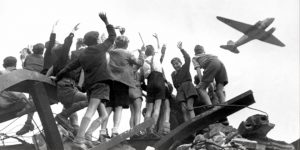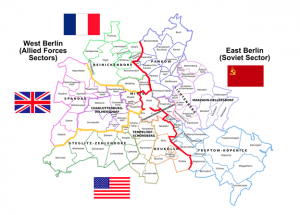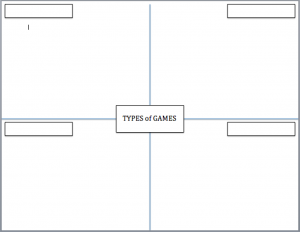Assignment #3 slides- Swing Rhythm Cheesecake
For my cross-genre translation, I adapted my theatre mini lesson on the elements of tableaux to be a recipe card. This conversion actually worked extremely well, and as it turns out, could be a useful tool for my classroom. There are a lot of drama activities and concepts that would translate well to a recipe card format (eg. large scale concepts like “Creating Character” to more specific micro-skills like selecting acting tactics) and having these cards available for students to reference in class could be a valuable learning and review resource for students when they’re working!
I think a recipe card could even work well as a graphic organizer if ever I wanted the students to take their own notes in class (which is uncommon in drama). They could build their own “Drama Recipe Box” with categories like “games,” “warm-ups,” or “creation tools,” which would give them a personalized, visual representation of the drama repertoire they had built throughout the course.
Top-Notch Tableaux Recipe Card
Update: Someone mentioned I should throw up the template. Here’s the pdf file — I tried to get up the pages file but it’s not supported by the blog. Feel free to email me if you’d like it.
Because I’m fancy I used a font called “Buttercup” for the template text.
If you’d like it, you can download it here: https://www.dafont.com/buttercup.font
Here’s my IFEA instruction manual for teaching musical phrasing! Enjoy!
This way of creating simple, use friendly step by step instructions was very useful for distilling what in real-time is a very subjective, sense-based, internalized process for students in a way to create access to this skill. This idea could be continued into other content areas within music (use of metronome or tuner, making program notes) as a fun and “known” way that could be handed out to students as a template to follow when learning a new skill.
Characterization Graphic Organizer
Short Story – Nancy Lee Johnson
For the literary device of characterization (direct & indirect) I decided to create a picture. I used my graphic organizer (attached above) to guide my visual character creation. I made choices while creating this that reflect her character as she is characterized in the short story: I decided to depict her race, her confidence, and a few of her interests.
I found that, although art and English are very different disciplines, I learned more about the character from creating this picture than I did from reading the story. The act of thoughtfully depicting Nancy Lee Johnson using her characteristics described in the story gave me an idea of a well-rounded character and what characteristics are important to describe/depict.
Marie-José did a great job teaching the text i gave her. She presented the information in a clear order and delivered the information confidently, even when she wasn’t exactly sure what something meant. She was very positive and also very aware of each student in the class. I have lots to learn from her!
Newcastle March – Johnnie Vinson
History and Characteristics of a March: Sonnet
Upon the hill the drums wait for their cue;
The bugles stare down on the field below;
The heartbeats match a tempo felt in two;
The sounds will lead with army near in tow.
The music in the park fills up the air;
The brass, the flutes, and drums beneath the arch;
A crowd begins to cluster ‘round and stare;
Familiar rhythms of a Sousa march.
A football field of padded, tall brigades
The halftime show permits the band to shine;
New Orleans streets are bustling with parades;
A funeral progression second line.
Percussion are the pulse, our steady beat
That keep a feel for march beneath our feet.
The Berlin Airlift & Containment
After the Soviets cut off surface traffic to West Berlin on June 27th 1948, the United States believed they had a right to be in Berlin, including the right to access. The Soviets however did not agree. Shipments by rail and road came to a halt. A desperate Berlin, faced with starvation and in need of vital supplies, looked to the West for help. President Truman, wishing to avoid war or a humiliating retreat, supported an air campaign that sent over two million tons of supplies in approx. 270,000 flights to Berlin. At this time, a man by the name of Gail Halvorson, better known as “Uncle Wiggly Wings”, from Utah, dropped a bunch of candy to children of the blockaded city. This is a recipe of Cold War Containment.
https://www.youtube.com/watch?v=OmanS-4nc4Y
The Berlin Airlift Student Activity
https://www.trumanlibrary.org/teacher/berlin.htm

KUED. (2013, 12 6). Inspiring Story of The Candy Bomber. Retrieved 05 27, 2019 from Google Sites: https://www.kued.org/pressroom/kued-tells-inspiring-story-the-candy-bomber
 Map of Berlin and Allied Nations
Map of Berlin and Allied Nations
Recipe of Containment- Operation Vittles (Food)
Materials/Supplies
Directions
Geetika did a great job facilitating a discussion on science communication. She effectively used the mind map as a framework to guide the discussion and presented the lesson in an engaging way.
Gregg explained my haiku template effortlessly and clearly! His background is also in English, so that definitely helped in the explanation process. He addressed the three main points in a concise manner (What is a Haiku?, Where does it come from? How is it relevant to Canada?). He was also able to break down the 5-7-5 syllable rule with the group members and guide them through the “word choice” process. He simplified the haiku writing process by encouraging the group members to use a thesaurus if they are having difficulty staying within the syllable count. We hadn’t discussed this so it was great to see that Gregg had ideas of his own to make the process easier! Overall, he presented the material in an engaging and clear manner!
Another great organizer is the following from ReadWriteThink.org Haiku Assignmned LLED 361
Devon did an excellent job presenting the information displayed in my graphic organizer. Despite not feeling confident in the subject area, she beautifully described and conducted an activity that allowed fellow peers to gather an understanding of the 4 game categories in physical education. All future students of hers are lucky!
Graphic Organizer:

Text:
Ellis M (1983) Similarities and differences in games: A system for classification. Paper presented at: The Internal Association for Physical Education in Higher Education Conference, Rome, Italy.